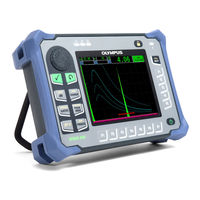Olympus EPOCH 650 Manuals
Manuals and User Guides for Olympus EPOCH 650. We have 2 Olympus EPOCH 650 manuals available for free PDF download: User Manual, Getting Started Manual
Olympus EPOCH 650 User Manual (362 pages)
Ultrasonic Flaw Detector
Brand: Olympus
|
Category: Measuring Instruments
|
Size: 5.38 MB
Table of Contents
-
-
-
Intended Use17
-
Safety21
-
Warnings21
-
China Rohs24
-
-
Introduction
27 -
-
-
Front Panel32
-
Connectors45
-
-
-
-
-
Escape Key65
-
Lock Key65
-
Submenus66
-
Sensitivity67
-
Pulser68
-
Receiver68
-
3.10 Gates70
-
Gate Setup71
-
-
-
-
Button Types86
-
Flags90
-
Setup98
-
Grid Setup Page103
-
About Page110
-
Clock Setup Page111
-
Misc Setup Page112
-
-
-
-
-
Reject127
-
Peak Memory128
-
Peak Hold130
-
Freeze130
-
Grid Modes131
-
Baseline Break134
-
-
7 Gates
135-
Gate Alarms145
-
9 Calibration
155-
Basic Setup155
-
-
Angle Beam Modes157
-
-
-
-
10 Data Logger
199-
-
2-D Epri201
-
2-D Matrix Grid201
-
Sequential201
-
Boiler202
-
-
File Menu203
-
Create204
-
Open209
-
Quick Recall216
-
Memo217
-
Manage Menu220
-
Reset221
-
Export222
-
Import223
-
Edit225
-
Copy226
-
Import Memo228
-
-
Grid View229
-
Screen Capture233
-
-
-
-
Dynamic DAC/TCG238
-
Jis Dac250
-
Dgs/Avg252
-
Scanning Gain265
-
Envelope Mode270
-
Crack Sizing271
-
Manual Mode273
-
Crack Sizing276
-
Interface Gate283
-
B-Scan297
-
B-Scan Setup299
-
Template Storage304
-
-
-
-
Troubleshooting311
-
-
-
B.3.3 2-D Epri329
-
-
-
B.3.6 Boiler331
-
-
List of Figures
347-
List of Tables
353 -
Index
355
-
Advertisement
Olympus EPOCH 650 Getting Started Manual (13 pages)
Ultrasonic Flaw Detector
Brand: Olympus
|
Category: Security Sensors
|
Size: 1.36 MB

